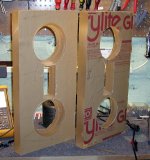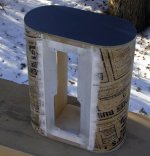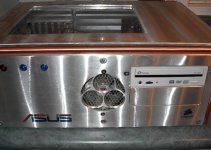Chartal said:
You are a gentleman and a scholar. I've just ordered two. Thank you.
I've used sharp regular cutters with a very slow feed - no coolant. I've had very good results. Maybe results would be even better with coolant.
The issue with using a router is control . You must not be in a situation where you are biting off more than a couple thousandths of an inch or it will try and take off, chatter, etc. Try and keep the cut much less than the depth the cutter is capable of in wood and use a jig to keep the cuts shallow. I've noticed that the finish that can be achieved is on par or better than with a conventional mill - probably due to the high cutter speed and the sharpness of the cutter. I have a mill now and I won't go back, but......
The issue with using a router is control . You must not be in a situation where you are biting off more than a couple thousandths of an inch or it will try and take off, chatter, etc. Try and keep the cut much less than the depth the cutter is capable of in wood and use a jig to keep the cuts shallow. I've noticed that the finish that can be achieved is on par or better than with a conventional mill - probably due to the high cutter speed and the sharpness of the cutter. I have a mill now and I won't go back, but......
Mr. Marino makes the best point of all.
The rigiity of the set up is paramount... and this is where a router is most lacking. You speak of a trammel... so I would guess that you're cutting circles? The smallest amount of play in the setup invites the bit to "bite off more it can chew". Once this occurs... the bit is bent and the router jumping out of the material. The path of of the router must be solidly confined in all directions... RIGID.
I have cut 2" plate on a table saw... just go slow.
As far as coolants are concerned... much depends on the metal. Better grades of aluminum... alloyed with copper and such; are much easier to cut cleanly. Look no farther than the fridge for coolant... good ole' lard makes an excellent lube for cutting aluminum.
Oh, and BTW... this will make alot of fine airborne dust.

The rigiity of the set up is paramount... and this is where a router is most lacking. You speak of a trammel... so I would guess that you're cutting circles? The smallest amount of play in the setup invites the bit to "bite off more it can chew". Once this occurs... the bit is bent and the router jumping out of the material. The path of of the router must be solidly confined in all directions... RIGID.
I have cut 2" plate on a table saw... just go slow.
As far as coolants are concerned... much depends on the metal. Better grades of aluminum... alloyed with copper and such; are much easier to cut cleanly. Look no farther than the fridge for coolant... good ole' lard makes an excellent lube for cutting aluminum.
Oh, and BTW... this will make alot of fine airborne dust.
Oops... forgot,
If your're doing 1/4" / 6mm plate; do it all in one pass. The corners of the bit are prime culprits when it comes to "biting off..." If you're not using the corners of the bit... so much the better.
If possible, find another method to plunge through the material... again, the router will work fine... as long as things are rigid enough.

If your're doing 1/4" / 6mm plate; do it all in one pass. The corners of the bit are prime culprits when it comes to "biting off..." If you're not using the corners of the bit... so much the better.
If possible, find another method to plunge through the material... again, the router will work fine... as long as things are rigid enough.
poynton said:In a similar vein, can perspex / plexiglass be routed with a 'normal' domestic router ?
Andy
I have not milled Plexi but have drilled it plenty of times, and while there are special bits for plexi (shallow attack angle) you can use generic bits, but it is of paramount importance to drill slowly and clean your bit every few mils so that heat does not build up under the surface. If you over heat Plexi, which is easy to do, a clean hole may show crazing and cracks will appear months after the work is done, usually directly to the closest edge. Also if you are discussing plastics (as with aluminum alloys) it is worth noting the particular grade/type as they have individual machining characteristics.
Simon
poynton said:In a similar vein, can perspex / plexiglass be routed with a 'normal' domestic router ?
I did 2" acrylic with a regular router and it was no problem (I did 1" at a time)
I find it to work best when router is attached to a table, the workpiece being rotated on a center set by a drill bit run through the table and workpiece (which sets the proper radius).
Attachments
The bottom cut out in the assembly pictured below was initially done with a jigsaw (1/4 aluminum) and later smoothed out with a router run on a template (so very little aluminum needed to be removed). Again, the router was mounted to a table, template attached on the inside.
Attachments
Peter Daniel said:...was initially done with a jigsaw (1/4 aluminum) and later smoothed out with a router run on a template (so very little aluminum needed to be removed).
I used that same method on a gaming computer I did a few years ago (previous obsession, before this one). It is 1/4" aluminum that I rough cut with a jigsaw and trimmed smooth with the router.
Attachments
poobah said:The corners of the bit are prime culprits when it comes to "biting off..."
Nice to see you here, but what's "biting off"? I need to cut a 3mm rebate.
"Biting off more than it can chew"... the problem being that if the bit is loaded the least bit too much... the router wants to jump out of the material, fixture, etc...
By rebate I assume you mean what we call a rabbit... a blind groove in the material?
Either way... I would still try to go it in one pass
By rebate I assume you mean what we call a rabbit... a blind groove in the material?
Either way... I would still try to go it in one pass
- Status
- This old topic is closed. If you want to reopen this topic, contact a moderator using the "Report Post" button.
- Home
- General Interest
- Everything Else
- Routing aluminium?




